Developing a vision for an integrated Darwin Harbour report card
Bill Dennison ·I traveled to Darwin, the Capital city of the Northern Territory of Australia, in order to work with the Darwin Harbour Advisory Committee on developing a vision for an integrated report card for Darwin Harbour. Karen Gibb, Charles Darwin University professor and chair of the Darwin Harbour Advisory Committee, hosted my visit. Jane Thomas, a former Integration and Application Network (IAN) Senior Science Communicator, and her husband Dave Loewensteiner, both now work at Charles Darwin University. They took the time out of their day to graciously squire me around the city.
This is not the first time I have been to Darwin, Australia. I have toured Darwin Harbour – which should be called Darwin Bay, it is so large – and have published several blogs and a newsletter detailing my experiences. Heath Kelsey, IAN’s Program Director, spent a sabbatical at Charles Darwin University with his family two years ago. During that time, we hosted two CDU faculty members, Michael “Dougo” Douglas and Samantha Setterfield. So this particular trip was just another facet of a long and productive relationship with Darwin Harbour and Charles Darwin University. We call this collaboration “Darwin-IAN.”
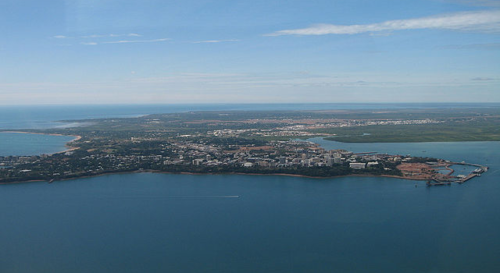
The Northern Territory Government has produced a Darwin Harbour water-quality focused report card for Darwin Harbour every year since 2009. Our discussions at the workshop aimed to extend this project to encompass ecological, social and economic indicators. I started off by reviewing the various report card innovations and developments in other locations like the Chesapeake Bay, Mississippi River, and the Orinoco River. I suggested improvements taken from these projects such as:
- Comprehensive report cards (ecological, social, economic aspects) are more useful for management
- Mapping out trends over time is as important as absolute scores
- Providing supporting web material is useful
- Engaging citizen scientists would be beneficial
- Delivering annual report cards to a high level of government with media coverage facilitates a constructive public dialog
Then I conducted three exercises to solicit ideas for the integrated Darwin Harbour report card. I started by having everyone write down the first three words that complete the sentence “Darwin Harbour is . . .” After this exercise, Jane Thomas took the words and put them into a word cloud. The biggest words in this word cloud were beautiful, large, unique and important.
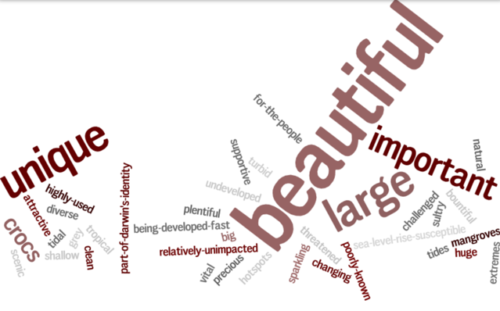
The next exercise was ‘Snap.’ For this game, participants wrote down three key values of Darwin Harbour. After pasting and grouping these key values on the board, we voted on the priority of each value. It pleased me to see how well the values grouped out into ecological, social and economic categories. The top ecological value was coastal ecosystems, with mangroves figuring prominently. The top social value was recreational fishing, along with aesthetic/cultural values. The top economic value was the port of Darwin.
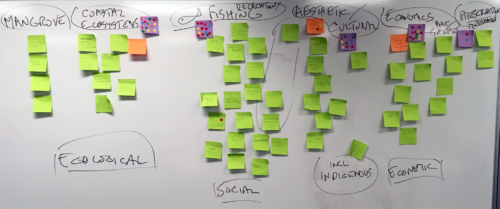
We then turned our attention to the major threats to Darwin Harbour, and used Snap to brainstorm the three top threats to its health. The top ecological threat was climate change, which included sea level rise, increased temperatures, and cyclones, and pollution. The top social threat was resources for management, due to possible political changes and economic decline, and the top economic threat was land use and planning, including habitat destruction and cultural conflicts.
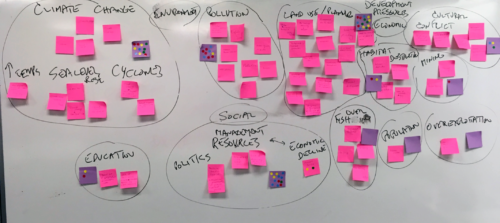
After facilitating SNAP, we introduced a stakeholder mapping exercise in which we grouped various sectors of society into the following: government, academia, industry, community, NGOs (non-governmental organizations), and indigenous. We placed each organization into a matrix of low to high influence and power, and low to high interest in our comprehensive Darwin Harbour report card.
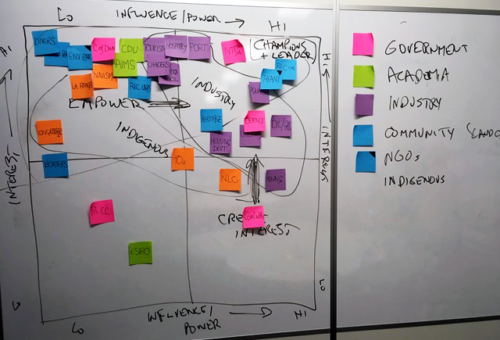
Some patterns emerged on this matrix. In the government grouping, different branches had very different matrix placements. Both the Northern Territory Government and the Australian Department of Defence stood on the high interest and high influence section of the matrix, the City of Darwin was less influential but still interested, the Commonwealth of Australia had higher influence but lower interest, and the Palmerston City Council was the least influential and least interested. Academic institutions were less influential as a whole, but had varying degrees of interest. The industry grouping contained a cluster centered in the highly influential and highly interested sector. The indigenous grouping was generally interested, but lacked influence. Community groups and NGOs were overall interested, but had variable amounts of influence.

After producing this matrix, we brainstormed recommendations for each sector. For those champions and leaders in the highly influential and highly interested sector, we recommended the following:
- Develop a value proposition for other groups to become more involved, capitalize on effective responses to events and crises
- Develop holistic and inclusive processes, serve as peer to peer industry leaders, and develop an approachable, inclusive attitude.
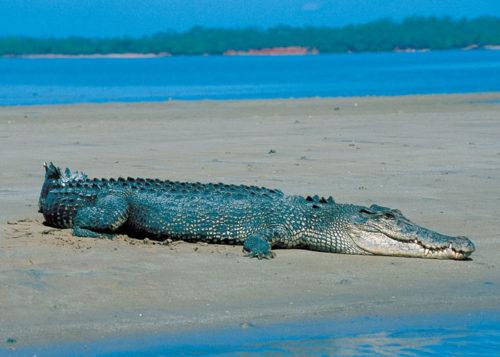
For the interested parties that need to be empowered we developed the following recommendations:
- Build trusted relationships using collaborative partnerships, communicate more effectively,
- Develop mentoring relationships
- Develop increased freedom and independence with a broader visioning and increased confidence
For the influential parties that need to be more interested we developed the following recommendations:
- Create peer recognition for good practices including peer groupings, use citizen science,
- Increase a sense of responsibility
- Create a national model for inclusiveness and shared leadership.
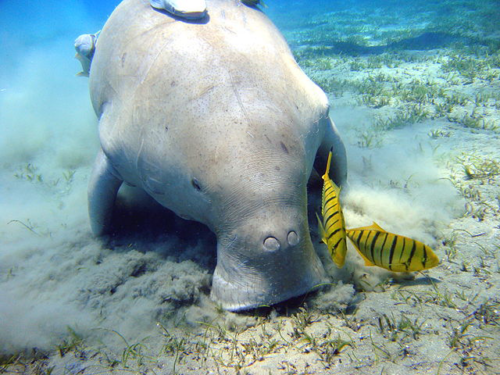
At the end of the session, I summarized the workshop recommendations:
- There is a very clear desire to incorporate ecological, social and economic indicators into a comprehensive Darwin Harbour report card, building on the ongoing water quality report card.
- Darwin Harbour can serve as an iconic tropical port city model, balancing industrial and economic development, indigenous values, and ecological status.
- Partnerships need to be established to co-design and co-produce a comprehensive Darwin Harbour report card.
- Government, academia, industry, community groups, NGOs and indigenous groups need to be included in the development of a comprehensive Darwin Harbour report card.
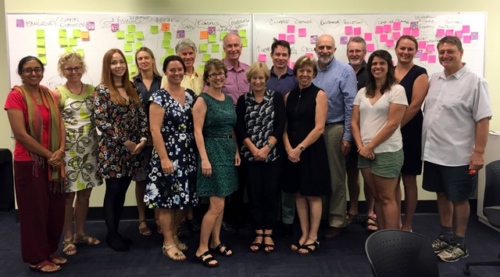
I felt so impressed with the level of interest, the diversity and amount of expertise, and the fantastic natural setting of this sparkling place, that I wrote the following poem to commemorate my visit:
Sparkling Darwin Harbour
14 September 2017
William C. Dennison
Darwin Harbour is large and beautiful
It's also unique and important
And in terms of crocodiles it is bountiful
And some say that it simply sparkles.
People care about coastal ecosystems, fishing and port development
But feel threatened by climate change and pollution
And also problems caused by land use development
They worry about being about coming up with a management solution.
Mapping out the Darwin Harbour stakeholders
Recognizing the complex society of the north
In sharing the burden, the weight is not on one set of shoulders
Working together, we can protect this amazing part of the earth.

About the author
Bill Dennison

Dr. Bill Dennison is a Professor of Marine Science and Interim President at the University of Maryland Center for Environmental Science (UMCES).
Next Post > Walt Whitman and The Celebration of Nature
Comments
-
Karen Gibb 7 years ago
This captures the day beautifully. I agree there was great spread of expertise, engagement and commitment. It's a sparkling place for sure and worthy of sparkling web-based report cards. The poem is a very nice touch. Thanks Bill for your continuing enthusiasm and positive input - the workshop was very successful - very much appreciated. And more to come.....